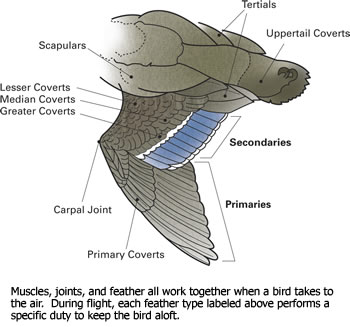Wings in Action
By J. Michael Checkett
From the raw speed of canvasbacks to the limb-dodging acrobatics of wood ducks, the flight capabilities of waterfowl have long inspired awe among hunters. As with all birds, a duck's flight characteristics are determined by the shape of its wings and the way it uses them. But biologists generally divide bird wings into four categories: slotted high-lift wings, elliptical wings, high aspect-ratio wings, and high-speed wings. Waterfowl are in the high-speed category, but there are differences among species that have this wing type.
All waterfowl species are suited to particular habitats, and it is easy to see how these varied environments, which present unique flight challenges, influenced wing evolution. Most puddle ducks frequent small marshes, sloughs, and flooded bottomlands. As a result, puddle ducks need large wings for fast takeoffs and twisting flight to dodge trees and other obstructions. But diving ducks frequent open lakes, rivers, and coastal bays, so they need wings built for flying at high speed over open water. Consequently, the wings of diving ducks need to be flatter than puddle duck wings, moderately long and narrow, and swept back like the wings of a fighter jet.

Looking at how each part of a wing functions offers insight into the flight dynamics of waterfowl. Primary flight feathers are rigid and provide thrust while flapping. Secondary flight feathers are shaped to give lift for gliding. The vanes of flight feathers have tiny hooks called barbules that zip together, giving the feathers the strength needed to form an airfoil. Wing coverts are softer than flight feathers and create a smooth surface for the air to flow over the wing, providing lift and keeping the bird flying efficiently. This feather arrangement gives a high-resistance down stroke and a low-resistance upstroke.
Flying is essentially a balance between two sets of forces: lift and weight, and thrust and drag. As a bird flaps its wings, most of the lift and propulsion is generated on the down stroke of the wings. But lift is also obtained from the secondary flight feathers as the wings are raised.
The size of the wing determines how much lift is generated. A species' body size and weight influence the size of wing needed for flight and dictate "wing loading," which is the ratio of wing area to body weight. The larger the wing surface in proportion to the bird's weight, the more easily the bird can become airborne. Wing loading determines the size limits of flying birds and puts severe constraints on nearly all large birds. It is easier for small birds to have wings big enough to support their weight than it is for large birds. For a Canada goose to have the same wing loading as a cardinal, the goose's wings would need to be nearly 10 times larger than they are. Wings of such gigantic proportions would be both physiologically and mechanically impossible. Because large waterfowl such as Canada geese and swans have high wing loading, these birds must make extended runs across the water to reach the speed necessary for takeoff.
Deficiencies in wing loading can be compensated, up to a point, by how rapidly a bird flaps its wings. Birds with small wings relative to body size, such as ruddy ducks, have high wing loading and must beat their wings rapidly to stay in flight. But ducks with larger wings in proportion to body size, such as mallards, have low wing loading and can beat their wings more slowly and still remain airborne.
The shape of a wing is also important, whether it belongs to a bird or an airplane. Air goes above and below the wing during flight. Air flowing over the upper surface of the wing has to move farther than the air flowing under the wing. In order for the two air flows to reach the edge of the wing at the same time, the air flowing above the wing must go faster, creating lift.
Takeoff and cruising speed are dictated by the aspect ratio of a bird's wing. Aspect ratio is wing length divided by wing width. Mallards and other puddle ducks have a lower wing aspect ratio than many diving ducks. Because a puddle duck's wings are typically large in relation to body size and have a lower aspect ratio, most puddlers can spring into flight and make sharp turns.
Puddle duck wings, however, are less efficient for achieving sustained high-speed flight. Since a diving duck's wings have a higher aspect ratio and are smaller in proportion to body size and weight, divers have to run across the water to take off and must flap their wings more rapidly to achieve flight. High-aspect wings allow diving ducks to attain faster flight speeds than most puddle ducks but do not afford maneuverability in tight spaces.
The size and shape of a wing give it different aerodynamic properties, which in turn give birds varying flight capabilities. Since all ducks have high-speed type wings, they must flap nearly continuously, regardless of wing size. While this is the most energetically expensive form of flying, it is also the most reliable for species that make long-distance migrations. Ultimately, wings enable ducks and other waterfowl to take off, sustain flight, and exploit specific habitats, all of which have important consequences for their survival.
Ducks Unlimited uses cookies to enhance your browsing experience, optimize site functionality, analyze traffic, and deliver personalized advertising through third parties. By continuing to use this site, you agree to our use of cookies. View Privacy Policy